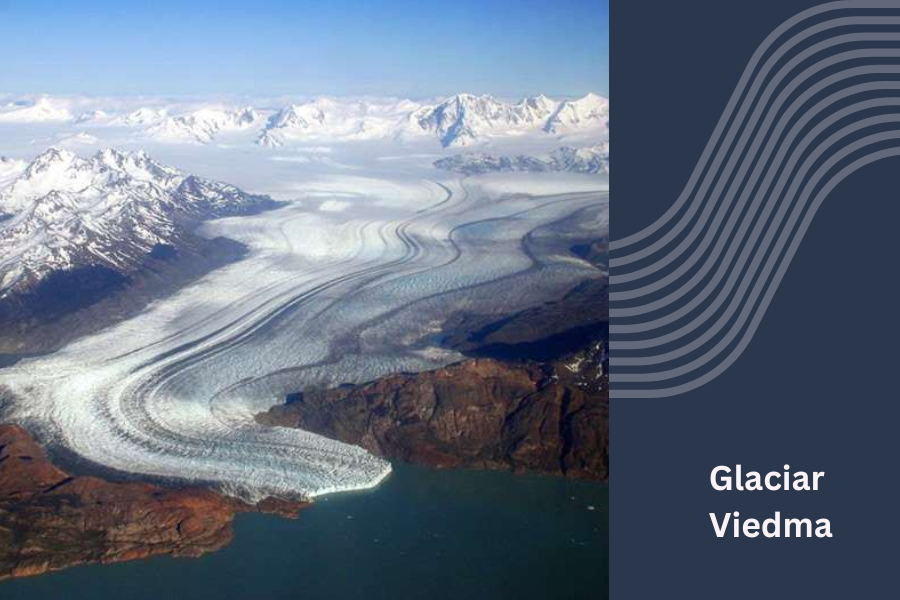
The Viedma Glacier: the ice giant of southern Patagonia
In the remote and rugged geography of the southern tip of Argentinian Patagonia, a blue ice giant looms imposingly between the snow-covered peaks of the Andes. It is the Viedma Glacier, which is considered the largest glacier mass after the South Patagonian Ice Field, to which it belongs.
With an area of 945 km2 and a length of around 80 km, the Viedma Glacier is a colossus that can only be experienced in all its grandeur from above or on a trip through the icy waters of the surrounding glacial lakes. A true experience of connecting with the era of the great glaciations.
The impressive Viedma tongue
The most impressive thing about the Viedma glacier is the enormous size of its main glacier tongue, which consists of several tributary tongues that join together to form a huge river of blue ice. This tongue is almost 50 km long and has an average width of 5 to 6 km at its narrowest point.
Imagine looking down from the mountain slopes or approaching this endless wall of ice up to 120 m high by boat. Huge towers and seracs of shearing ice rise up everywhere, exuding a cold and powerful blue silence.
Outlet into Lago Viedma
All these colossal glacier tongues eventually flow into the meltwater of Lago Viedma, from whose shores you have one of the most impressive views of this Patagonian giant. Enormous masses of ice break off there in a process known as “calving”.
The impact of these huge icebergs on the water creates powerful waves that spread out in all directions, causing a tremendous roar that echoes off the surrounding mountains. This is one of the most impressive natural spectacles of all.
View of the blue ice from the Viedma viewpoint
For the thousands of visitors who come to the region every year to see this glacier, the Viedma viewpoint is one of the main attractions. Located on the southern shore of Lago Viedma, this viewpoint offers a panoramic view of almost the entire extent of the glacier’s front.
From here you can admire the mesmerizing, bright blue color of the ice, which is the result of thousands of years of compression. The huge crevasses and caves that form on the walls due to the gradual movement and pulling of the ice can also be seen from here. An unforgettable spectacle, even if you are not on the water.
Crossing the continental ice
The most comprehensive experience to get to know the Viedma is the crossing of the continental ice, an excursion lasting several days with an overnight stay on the slopes of the glacier. This adventure involves walking on the surface of the ice with crampons, crossing deep crevasses and climbing up slopes covered in thousands of layers of bluish ice.
The reward is reaching some of the most remote base camps in the Andes mountains. From there, unique views of the snow-capped peaks of the Andes and other glaciers of gigantic proportions open up.
Boat trip on the waters of the glacial lakes
Another way to explore the Viedma area is to sail the icy waters of the glacial lakes that it feeds with its meltwater runoff. These trips on boats such as the Mare Australis catamaran allow you to get very close to the glacier front.
You can see the mighty ice wall in all its glory and the huge detachments of icebergs and seracs that create powerful waves. A sound and a sight worthy of the most remote regions of Antarctica.
The turquoise waters of these glacial lakes also offer the opportunity to admire the intense color contrasts and the infinite reflections of the bluish ice of the Viedma. A spectacle of color that constantly changes depending on the time of day and weather conditions.
A glacier giant, born from thousands of years of ice
Looking at the enormous dimensions of the Viedma Glacier is like stepping back in time to the great ice ages, when huge, thousand-year-old layers of ice covered a large part of Patagonia. In fact, the Viedma Glacier itself is a remnant of that time and is fed by the same continental ice fields from which it was formed.
The Southern Patagonian Ice Field, with its 13,000 km2 of glacier-covered area, is one of the largest ice masses on earth after Antarctica and Greenland. Only at the foot of this blue giant can we appreciate the true shaping power of the glaciers on the physiognomy of Patagonia.
Click here for the glacier forum
Frequently asked questions
Where is the Viedma Glacier located?
The Viedma Glacier is located in the southern part of the Los Glaciares National Park in the province of Santa Cruz in southwest Argentina. It is part of the Southern Patagonian Ice Field.
How do you reach the Viedma Glacier?
The front of the Viedma Glacier is not easily accessible. The closest option is to reach Bahía Túnel by boat from El Chaltén or El Calafate and hike from there to get partial views of the glacier.
What are the characteristics of the Viedma Glacier?
- The Viedma Glacier is one of the largest glaciers in Argentina, covering an area of around 975 km².
- It has a length of about 60 kilometers and a 6 kilometer wide glacier front.
- It is an outflow glacier that flows from the South Patagonian Ice Field into Lake Viedma.
- It is part of the Argentine Lake basin, which is fed by several glaciers.
How big is the Viedma Glacier?
The Viedma Glacier has a total area of around 975 km², making it one of the largest glaciers in Argentina and South America.
What activities can I do near the Viedma Glacier?
The main activities in the area include trekking, bird and animal watching, sailing on Lake Viedma and the nearby rivers. Kayaking and rafting trips are also possible. However, it is not possible to access the glacier front directly.
Map Viedma Glacier

